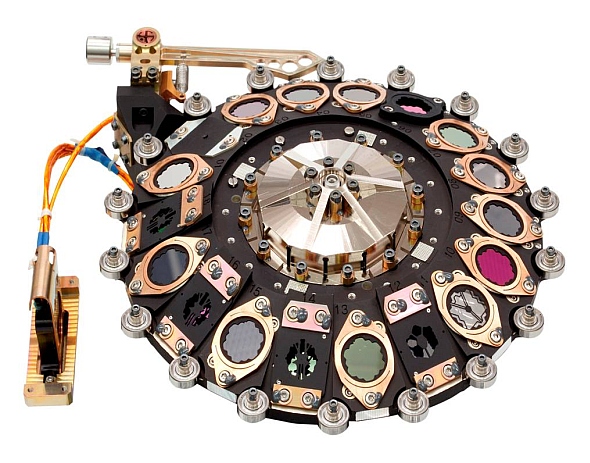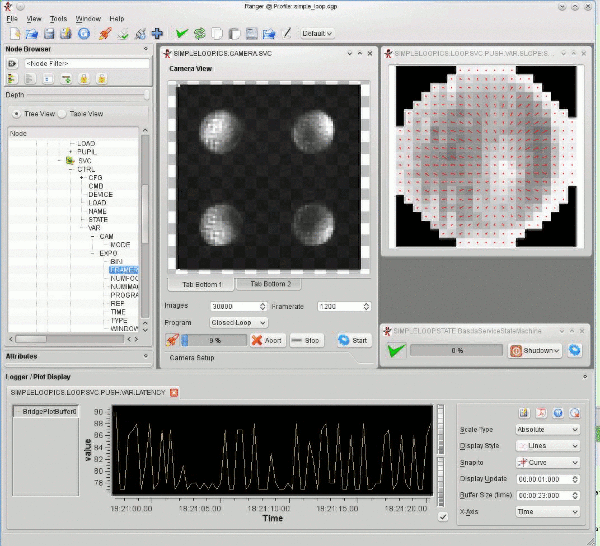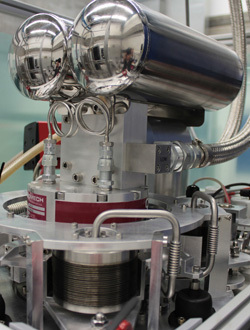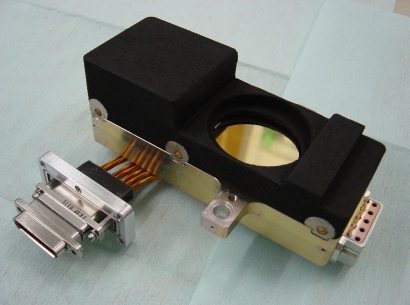| Version 223 (modified by , 8 years ago) (diff) |
|---|
The AstroTechTalk (ger) offers a place to discuss, for all interested colleagues and especially for the technical departments, the project leaders, the administration and the scientists as the ultimately users:
- status of instrumentation projects
- scientific tasks and features of the instruments in construction or planned
- new possible involvements
- technical innovations and developments
- technical problems and their solutions
- logistical problems and their solutions
- how to improve operation and observation
- project standards.
Time: Always Fridays 11:00 - 12:00
Location: Hörsaal
Outline:
- Announcements (news, visitors, etc.) (mainly in German)
- Talk of about 30 min about a selected topic (German or English, will be announced)
- Follow up discussion and questions (German or English, depending on the speaker)
Proposals for talks: Please send an email to "hofferbert -at- mpia.de" or "naranjo -at- mpia.de" - alternatively you might reach us by phone (06221-528209 or -290) or in person (room 211 or 018) at MPIA.
| Date | Speaker | Topic |
| 16.09.2016 | Michael Biermann (ARI) | GAIA as seen by a First Look Scientist As a daily routine, the Gaia First Look Scientists evaluate the quality of the scientific data and check the status of the Gaia instruments. In this talk a few examples out of the pool of findings by the Gaia First Look Scientists will be presented and discussed. This should -on the one hand side- highlight the capability of this highly accurate astrometry mission, but -on the other hand side- also demonstrate the problems of the related data analysis work. Presentation: German Slides: English Questions: German, English |
| 23.09.2016 | Anna Boehle (UCLA) | Upgrade of the detector in the integral field spectrograph OSIRIS OSIRIS is a near-infrared (1 - 2.5 microns) integral field spectrograph (IFS) on the Keck I 10-meter telescope in Hawaii. This adaptive-optics-fed instrument uses an array of small lenses to sample a rectangular section of the focal plane, producing up to 3,000 spectra simultaneously with a spectral resolution of ~3,800 and diffraction-limited spatial resolution. The unique capabilities of this IFS have allowed it to contribute to a variety of science programs since its commissioning in 2005, such as characterizing the atmospheres of extrasolar planets and tracing the motions of gas and stars at the centers of the Milky Way and other galaxies. In January 2016, the detector in OSIRIS was upgraded from the original Rockwell Hawaii-2 to a Teledyne Hawaii-2RG with lower read noise, lower dark current, and higher quantum efficiency. In addition to the upgraded detector, the detector head was also mounted on a linear stage, allowing the position of the detector to be accurately adjusted along the optical path when the instrument is at cryogenic temperatures (~80 K). This linear stage greatly reduced the number of cool downs required to put the detector image plane at the spectrograph camera focus and adjust any residual tip/tilt of the detector image plane. In this talk, Anna Boehle will give a brief overview of integral field spectroscopy and its advantages and challenges and also present the details and the results of the upgrade of the OSIRIS detector. Presentation: English Slides: English Questions: German, English |
| 30.09.2016 | Martin Kuerster | A special planet on our cosmic doorstep: Proxima Centauri b The recent discovery of a potentially Earth-like planet around our nearest stellar neighbour Proxima Centauri has made a splash. In this talk Martin Kürster will tell us how this discovery was made, why it is special, and how the study of this planet is supposed to continue. The talk will be widely understandable as the speaker would like to reach all interested colleagues at the institute. After all, each of us contribute our share to making these amazing scientific results possible. Presentation: German Slides: English Questions: German, English |
| 07.10.2016 | Silvia Scheithauer | CIAO - Wavefront sensors for GRAVITY GRAVITY is a near-infrared instrument for the Very Large Telescope Interferometer (VLTI) at the ESO Paranal observatory in Chile. GRAVITY combines the light of all four 8,2m telescopes to mimic a virtual 130m telescope. The thereby possible, drastically increased sensitivity and resolution, however, can only be reached, if the image blur due to atmospheric turbulence above every single telescope is corrected by the real-time deformable mirrors of an adaptive optics system. Hence, GRAVITY has to provide not only the „Beam Combiner Instrument“ (BCI) in the VLTI-lab, but also four infrared wavefront sensors to analyze the atmospheric turbulence. These wavefront sensors are located in the four Coudé-rooms of the telescopes, therefore called „Coudé Infrared Adaptive Optics“ (CIAO). The CIAO wavefront sensors were built under the responsibility of MPIA in close cooperation with ESO and the MPE-led GRAVITY consortium. While the BCI has been installed already in October 2015 on Paranal, the assembly of the four CIAO systems lasted from February to September 2016. Currently, the scientific commissioning of the complete GRAVITY instrument is ongoing. One important scientific goal is the observation of objects in the direct vicinity of the black hole in the center of our Milky Way. In addition, GRAVITY will allow to study young stellar objects and shaped-up stars with an unprecedented sensitivity. In spring 2017, when the galactic center is again observable from Paranal, observations of the star „S2“ will start. The close fly-by of this star relative to the black hole will allow to test Einstein's general theory of relativity with an extreme accuracy. Presentation: German Slides: English Questions: German, English |
| 14.10.2016 | Claudia Reinlein (Fraunhofer IOF, Jena) | Deformable mirrors |
| 21.10.2016 | Eike Guenther (TLS, Tautenburg) | Instrumentation projects of the TLS Tautenburg |
| 28.10.2016 | Santiago Barboza | The MICADO de-rotator test stand |
| 04.11.2016 | Stefan Hippler | Adaptive optics for VLT and E-ELT |
| 11.11.2016 | Vianak Naranjo | Characterization of Infrared Detectors - What is that? |
| 18.11.2016 | Sascha Douffet | Safety officers - Main actors and their tasks The last talk about occupational safety gave an overview, covering history, structure, regulatory framework and tasks. Since the topic is very complex, important questions are still to be answered about the main actors and their tasks. The following topics will be discussed in the second part: Who are the main actors? What means "responsibility" with respect to occupational safety? What are the main tasks? What may happen, if responsibilities are not assumed and tasks are not fulfilled? Every employee should know, which functions and activities are implemented at MPIA. Not only every colleague should know who is responsible for occupational safety, also the responsible persons should know about their tasks, such that those become a practical reality in the day-to-day work. And hence, the risk for accidents is automatically reduced. Presentation: German Slides: German Questions: German, English |
| 25.11.2016 | Michael Boehm (ISYS, Stuttgart) | OVMS+ for the Large Binocular Telescope |
| 02.12.2016 | Thomas Bertram | Integration, installation and alignment of LINC-NIRVANA at the LBT |
| 09.12.2016 | ||
| 16.12.2016 | ||
| 23.12.2016 | -- | Christmas break |
Preview:
Postview:
Presentations from 12.09. - 31.12.2014
Presentations from 01.01. - 31.07.2015
Presentations from 01.08. - 31.12.2015
Attachments (11)
- instrum8_gr.jpg (82.6 KB) - added by 10 years ago.
- instrum4_gr.jpg (104.4 KB) - added by 10 years ago.
- pedv3_gr.jpg (213.9 KB) - added by 10 years ago.
- alfa3.5.gif (235.6 KB) - added by 10 years ago.
- CIAO.jpg (3.8 MB) - added by 8 years ago.
- linc_nirvana_labor.jpg (255.2 KB) - added by 8 years ago.
- MATISSE.jpg (43.1 KB) - added by 8 years ago.
- miri_fm_filterwheel.jpg (145.6 KB) - added by 8 years ago.
- PACS-Chopper.jpg (80.0 KB) - added by 8 years ago.
- simple_loop.gif (965.4 KB) - added by 8 years ago.
- teaser.jpg (13.5 KB) - added by 8 years ago.
Download all attachments as: .zip







